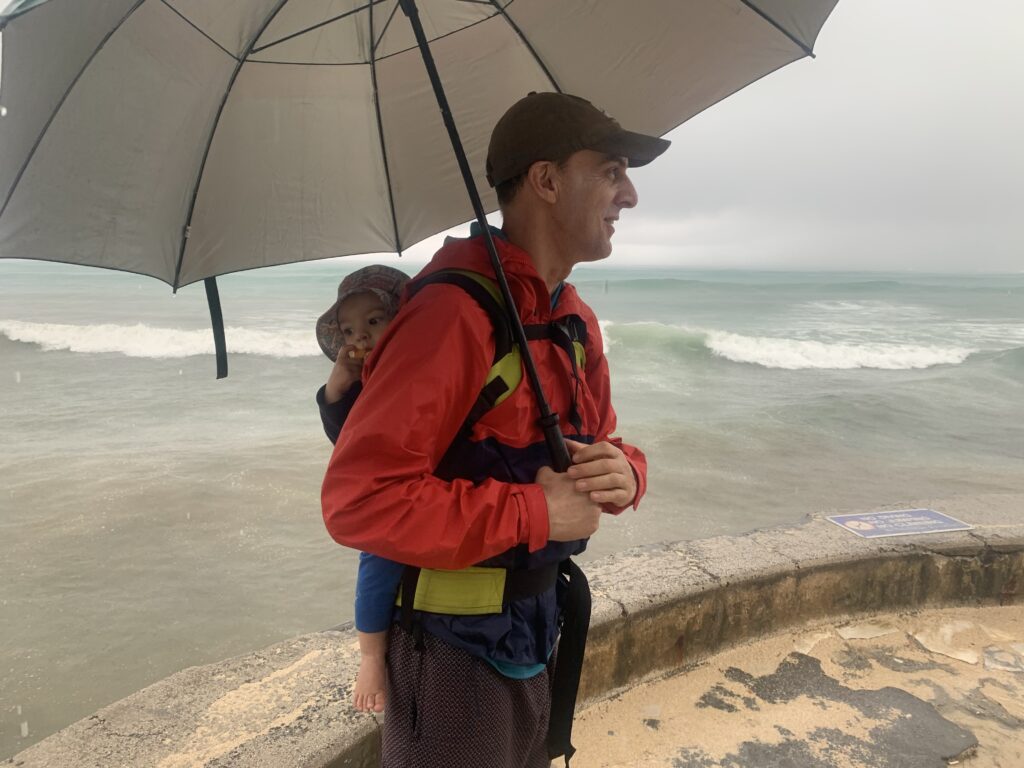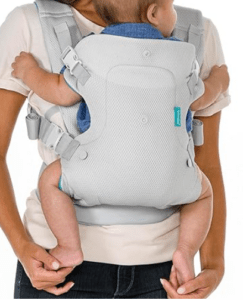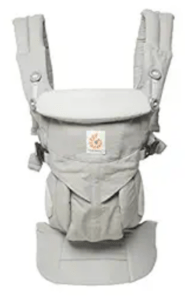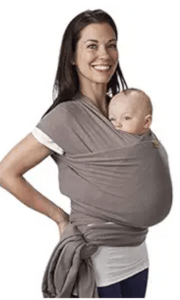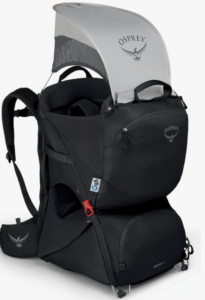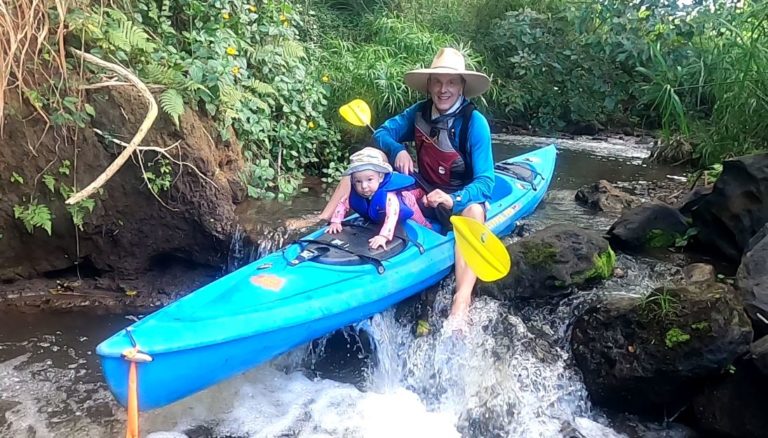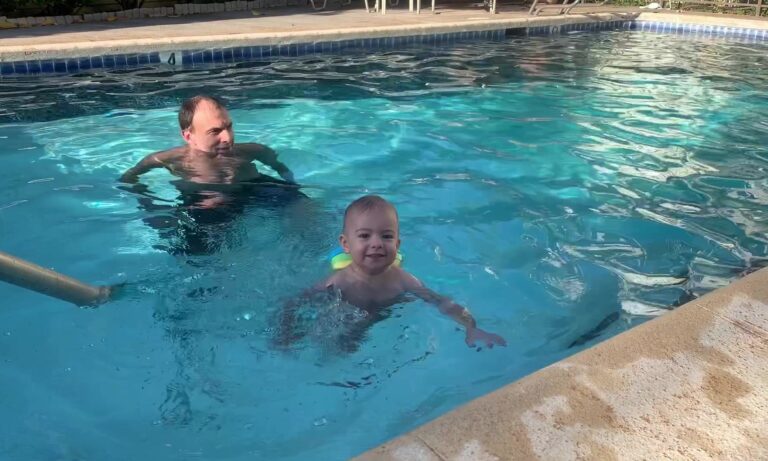Review of three main types of baby carriers on the market: the cloth wrap, the convertible carrier, and the high-tech backpacking style of carrier. This article looks at using the carriers while hiking, running errands and just doing chores at home as well as tricks to enjoy using baby carriers. While all three have advantages that we will discuss, the convertible baby carrier is by far the best bang for your buck and probably the one you will use the most.
When our daughter was light we definitely preferred baby carriers over a stroller. We could feel the baby to know when she was awake, asleep and if she was hot or cold. I could feed her with a bottle while walking and it was easy to get around the grocery store, a busy sidewalk without the stroller or load in the car. At a certain point she became heavy enough that a stroller became advantageous.
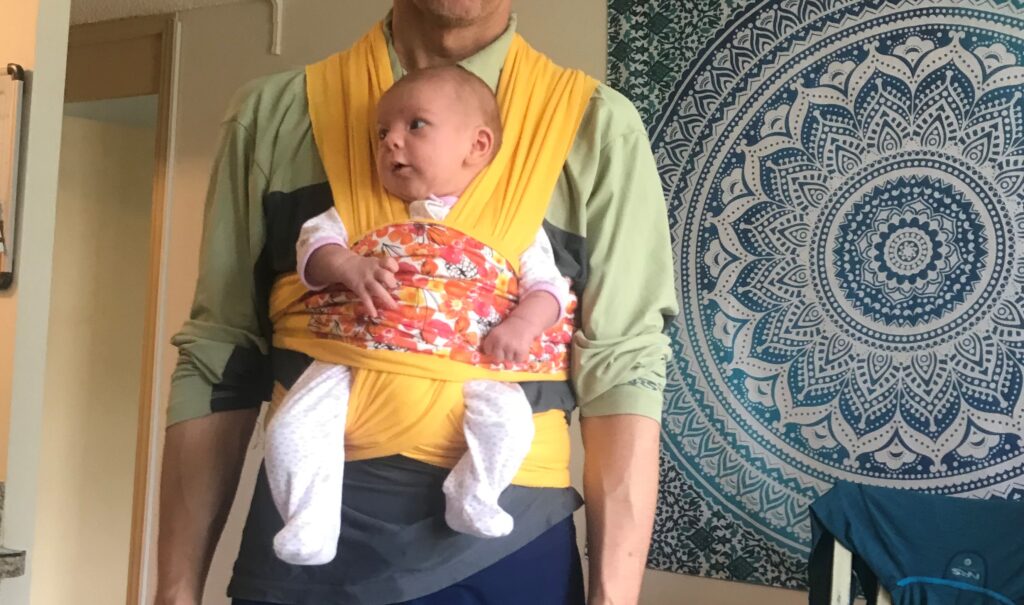
The Wrap
You’ll see lots of newborn babies carried in the wrap set-up. Basically it is a 12 inch by 6 foot long piece of material that you wrap around yourself. The biggest challenge is getting yourself wrapped in it with the right amount of tension. Sometimes this takes multiple tries. Other than that, it is amazing.
The wrap is by far the most comfortable of the three styles to wear. Whether the baby is in or out of it, you barely notice it is on. I like that you don’t have to take it off when making a short drive between errands and it is easy to get your baby in and out of it. The wrap feels like the most comfortable and adjustable of the 3 styles for a young baby as well.
We used the wrap for a 6 mile hike when our daughter was young and she appeared comfortable, content, and secure the entire journey. Some moms appreciate the ability to discretely breast feed while the baby is in the carrier. They are inexpensive ($20 to $40) and pack small, making one easy to bring on a trip. Just throw it in washing machine to clean, much easier and quicker than the other two types.
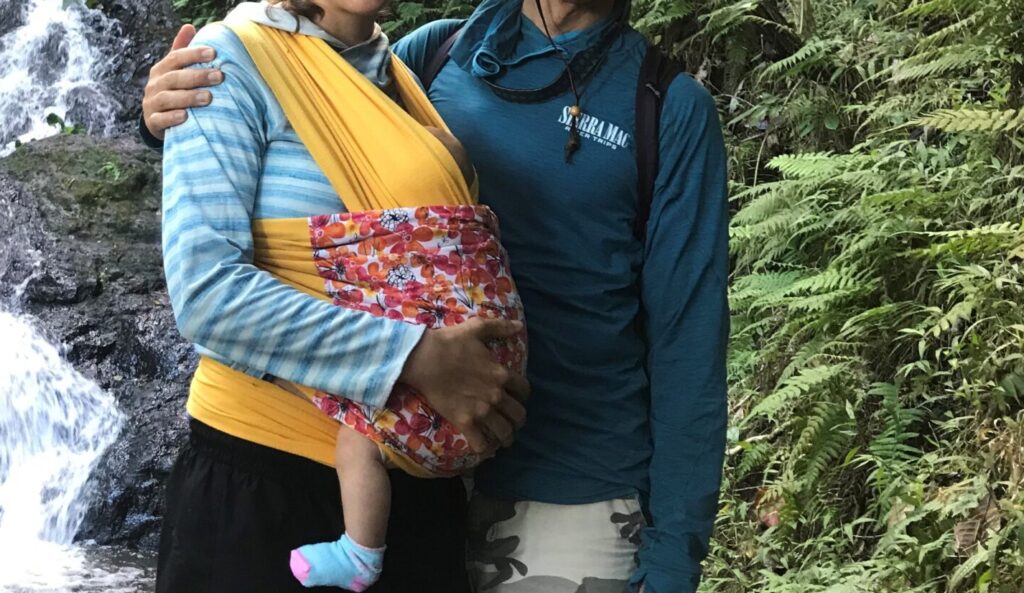
Wrap Brands
Since this is such a simple piece of gear, don’t over think it. The basic wraps work perfectly. You see upgraded versions online that have been sewn together in places. They might be easier to take on and off but they don’t seem nearly as adjustable for the child or the parent. Both my wife and I loved wearing the standard wrap. Wraps have been used around the world for thousands of years.
Minimial Use
Once our baby could hold her head up she much preferred seeing the world around her. On occasion I had her facing out in wrap. While it definitely wasn’t designed for this, it worked surprisingly well. Theoretically the wrap is good for babies up to 35 lbs. but it seems like babies age out of it between 3 and 6 months of age. This was the biggest issue with the wrap, we didn’t use it that often or for very long. That being said we kept it to use with our second child. Also, it is nice to have multiple carriers for when your baby gets poop all over one of them!
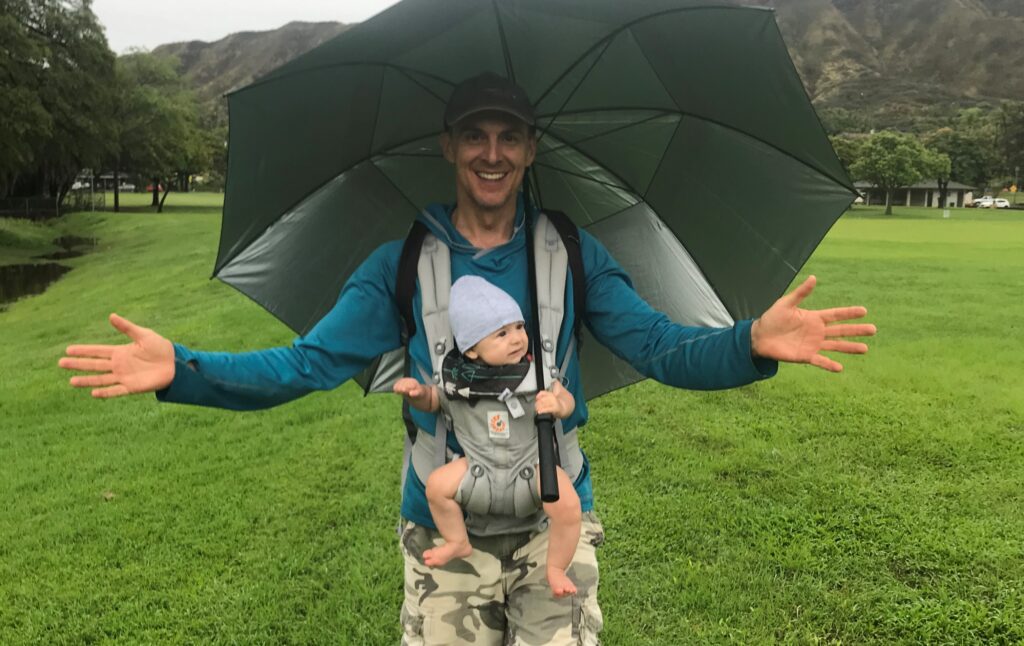
Convertible Carriers
Convertible baby carriers start around $40. They look like a small backpack but it has a baby in it. Original they were designed to have a young baby on your chest facing towards you, When they got bigger you could switch the carrier to your back and carry your toddler there. Over the years, the designs have been upgraded to add a middle step of having the baby face forward while on your chest.
The convertible carriers are much easier to put on and take off than the wraps. However, some of them can be a little confusing on how to adjust to properly fit your baby with all the settings and clips. These carriers are lighter weight and easier to pack than the large backpack carriers. The more expensive convertible carriers like the Ergo Baby seem simpler to use.
Inward Facing on the Chest
This position works well for newborns and young babies. You can feel them breathing and moving. Since they are on your chest, their body temperature will stay similar to yours. Some of the convertible carriers need an insert to work with the little ones (less than around 12 lbs). It can be a little more difficult getting the baby and the insert in place at the same time. Once in they are definitely secure. If they drop a big poop you might get lucky and only have to clean the insert.
Facing inward, babies can’t see much, particularly when small. I only liked this position prior to our baby being able to face forward. After that point, we would have her face inward on the rare occasion when we needed her to nap in the carrier.
Forward Facing on the Chest
Forward facing on my chest is by far my favorite way to carry a baby once she can hold her head up and look around. She is close to eye level of other people allowing her to be more interactive and involved in the conversations. I also felt like she moved around more in this position. Plus I knew where she is looking and I could talk with her about what is happening. Finally, I’d know her hat is still on her head.
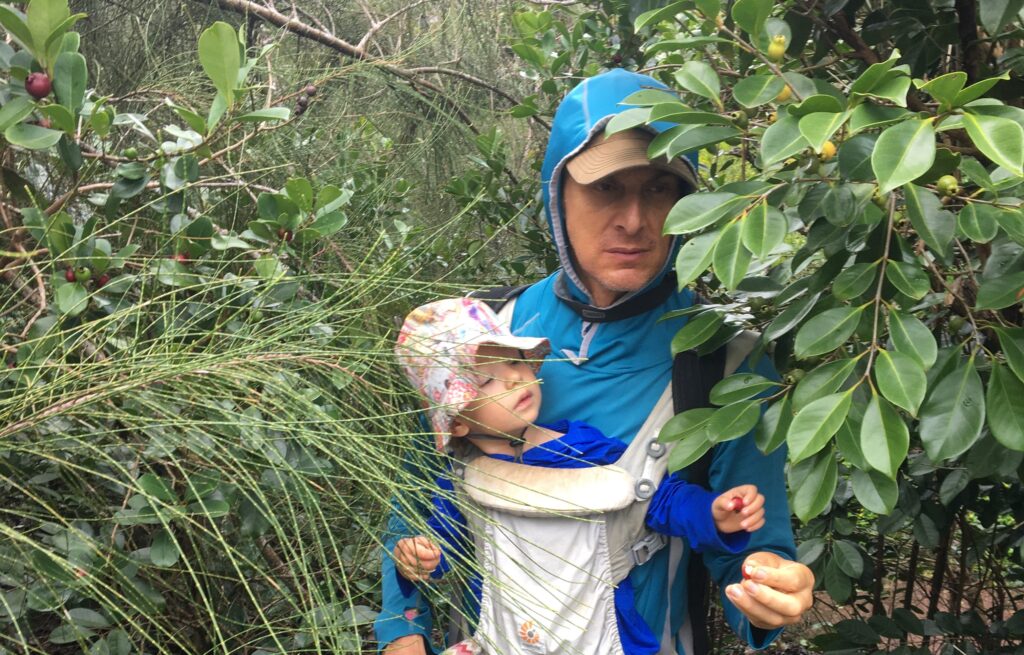
Our baby loved facing forward in the front carrier, she kept wanting to do it even as she got too big and I worried about her head whacking me in the teeth. Routinely, I would bottle feed her in this while walking and as she grew older feed her food and water. Also this position made it easy to carry backpack with supplies on my back when I was without my partner.
It can be hard to see where you are walking when carrying a baby on your front. I once tripped and fractured my the radial head (my elbow) but luckily caught myself before crushing her.
Sun Protection
We found a UPF sheet (sarong) that we tucked over her to protect her legs, feet, and sometimes arms from the sun allowed us to minimize our need for baby safe sunscreen.
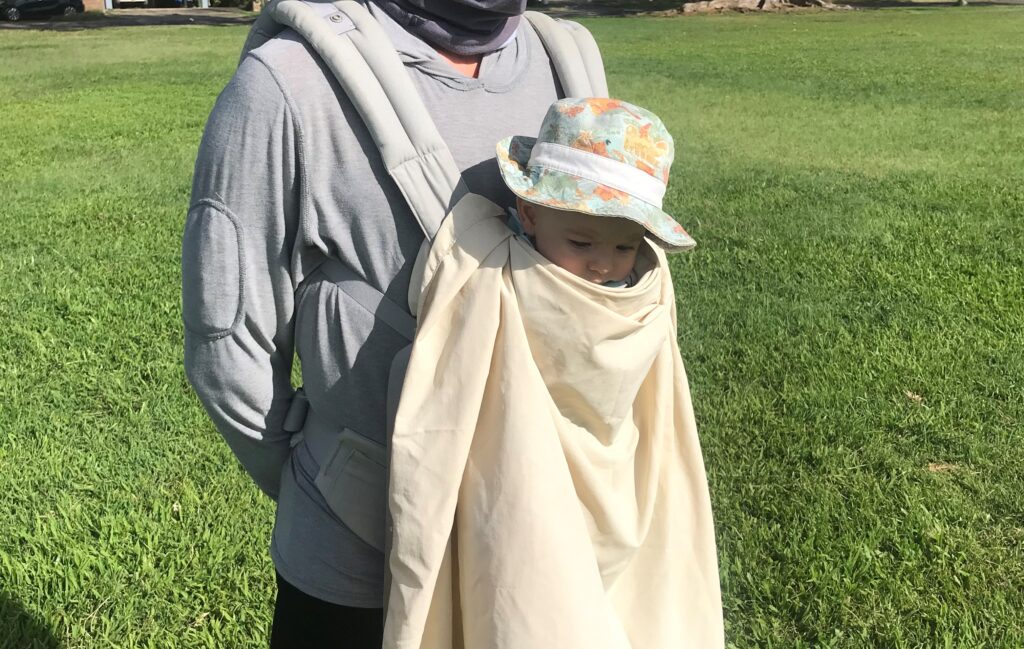
Convertible Carrier on the Back
At the point where your kid needs to be on your back many people go with the large industrial baby backpack that looks ready to summit Mt. Everest. The convertible carrier was still better in most ways at this point. First the convertible carrier is light weight and easy to bring on any trip. Second it is way cheaper.
We also liked it because with our toddler directly on our pack our center of gravity was better than with the big backpacks where the weight was farther out behind you and up higher. It is also easier to duck under trees and branches on a trail with the convertible carrier. I was part of a baby hiking group and no one used the big carriers.
A popular carrier was the budget friendly Infantino Flip for these multi-hour hikes. Some of the smaller moms would be carry 30 lbs kids up steep hillsides comfortably in their carriers. The light green carrier in the photos is an old Ergobaby. We preferred it over the light grey newer Ergobaby version seen in many of the photos because the older one had flatter shoulder straps much more similar to modern backpacks.
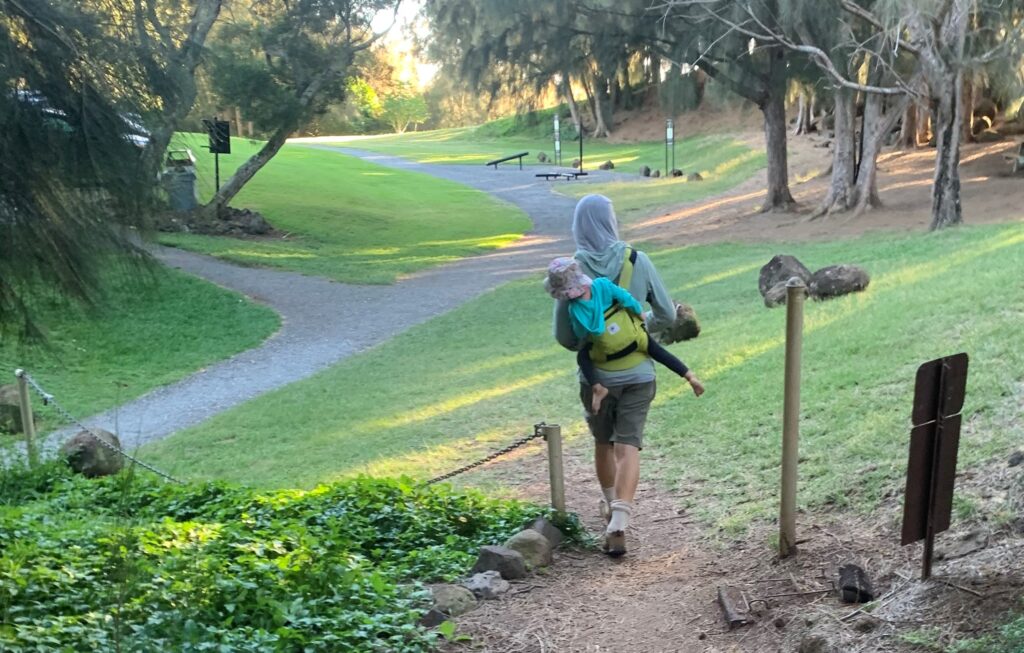
How to Load Baby in Back Carrier
The video below is for the Ergobaby. The Infantino Flip video does not show loading a baby solo while standing and it appears much more difficult with the buckles that must be fastened. As our daughter became a solid walker, I would just sit down, take off the shoulder straps and she could walk off. When I wanted her to get back in I’d sit down and she would walk up behind me and I’d pull the straps around her and stand up.
Tricks to the Baby Back Carrying
The annoying part of carrying your kid right on your back is she will mess with your hair, sunglasses and hat at times. I found wearing a hooded hiking shirt helped minimize this. It is also challenging to bring a backpack with the back carrier and there is minimal space to bring gear in the carrier. The best and most popular option in our hiking group was using a fanny or hip pack with a minimal amount of supplies: extra diaper with a few wipes, food, and water.
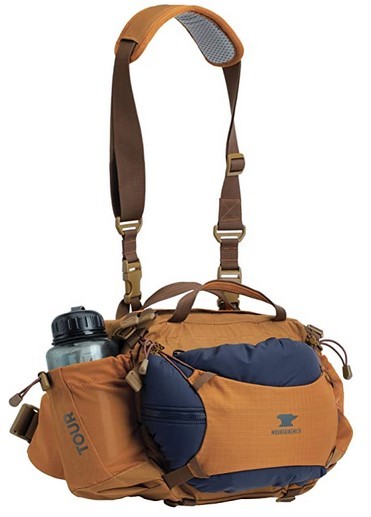
Use a Hip/Fanny Pack
Carrying a backpack on the front gets hot with the baby on your back. It makes it hard to see and impacts your stride when going up stairs and hills. A hip pack can be turned to the side to be out of the way and does not impact vision nearly as much. It is even better if your hip pack has a shoulder strap to be able to easily slid it far to the side.
Hiking Breaks
Carrying our daughter on our backs we have done many 2+ hours hikes. After 45+ minutes I noticed sometimes when she would get down she’d need to find her legs and I worried a little that she wasn’t getting good blood flow. When we stopped for break, I would let her down for a bit. This was much easier to do in the convertible carrier than the backpack carrier.
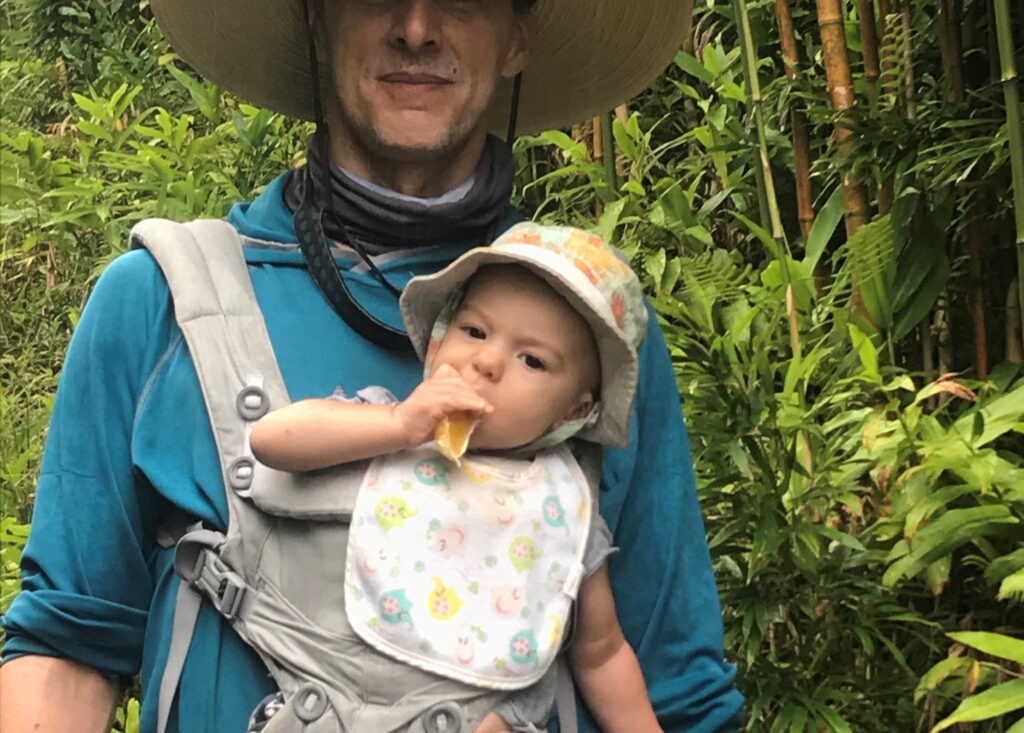
Dirty Baby Carriers
These packs get dirty between drool, sunscreen, food and dirt. While the darker colors are nice for hiding the dirt, the light colors don’t collect the heat nearly as much. The places that get the dirtiest are the bib area when the baby is facing forward (we ran a soft bib much of the time to try to minimize this). When on the back our daughter grabbed the shoulder straps often which end up getting dirty from leftover snack debris and dirt on her hands. Washing this type of carrier is a bit of a pain as it takes over a day for them to air dry.
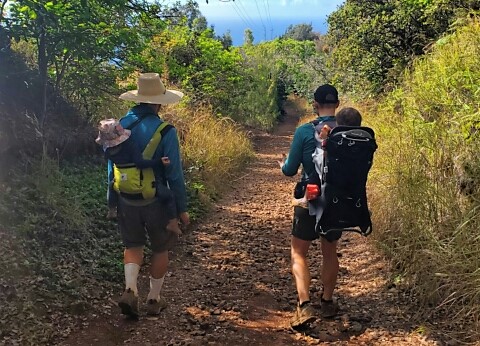
Child Carrier Backpacks
If you’re into gear the big backpacks are really cool. They have a bunch of clever engineering, including a pop up shade covers, stirrups for the kids to put their feet in, and a harness that would hold your kid in if you turned the hole backpack upside down.
The big advantages of these packs is that the kid has a superior view, better shade coverage and it isn’t as hot on the parent carrying the kid. The backpack carrier looks like it might be a little more comfortable than the convertible carriers but we didn’t notice much of a difference for our daughter, minus the shade protection on a hot hike.
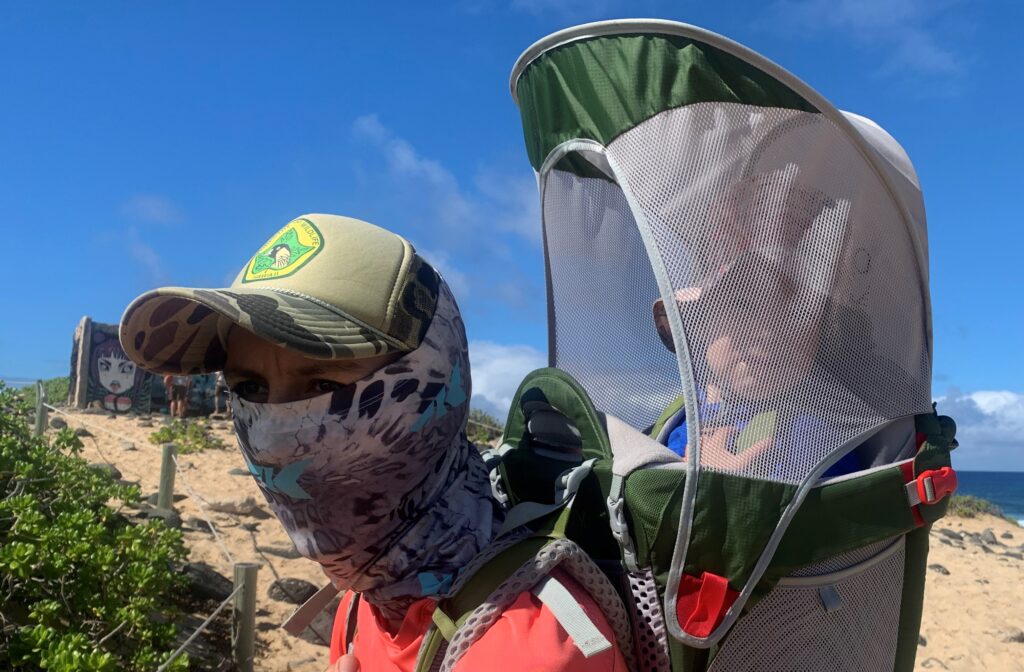
Poor Center of Gravity
The center of gravity on backpack carriers is much higher and farther away from your body putting more force on your body. You have to be careful when ducking or leaning around bushes and trees since the pack will start to pull you over. It also weight 20+ lbs versus the 1.7 lbs of the convertible carrier. I feel stiff and unathletic wearing the big backpack carrier.
Load and Unloading a Toddler
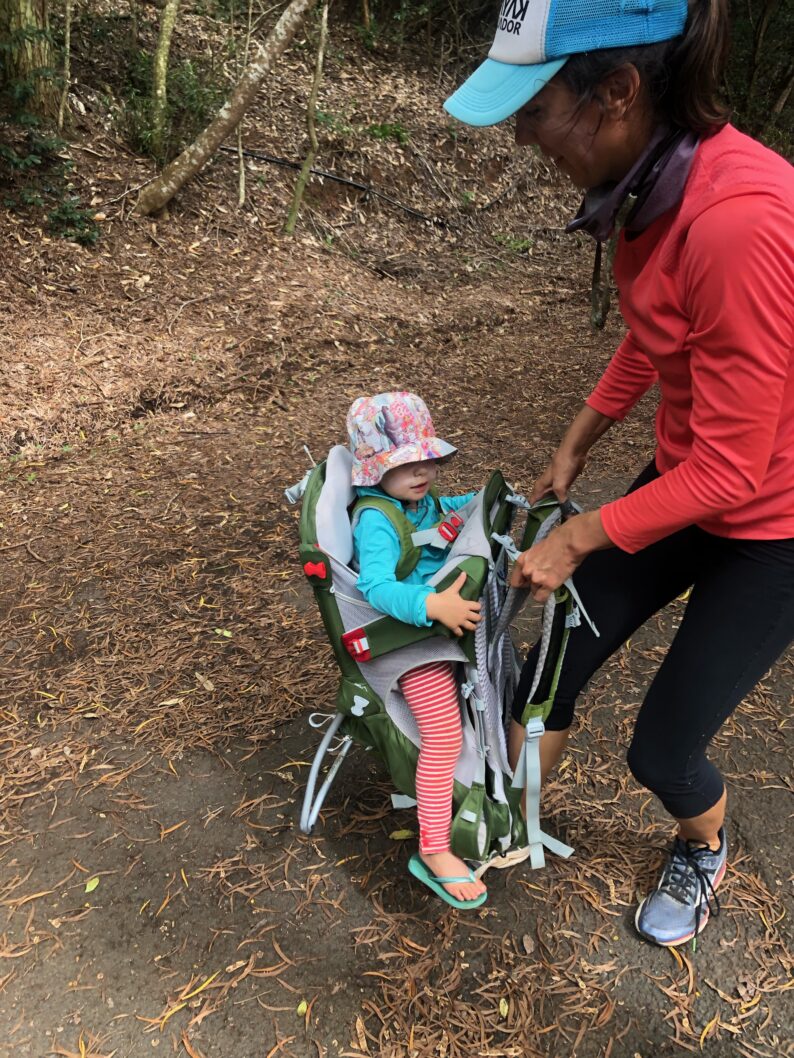
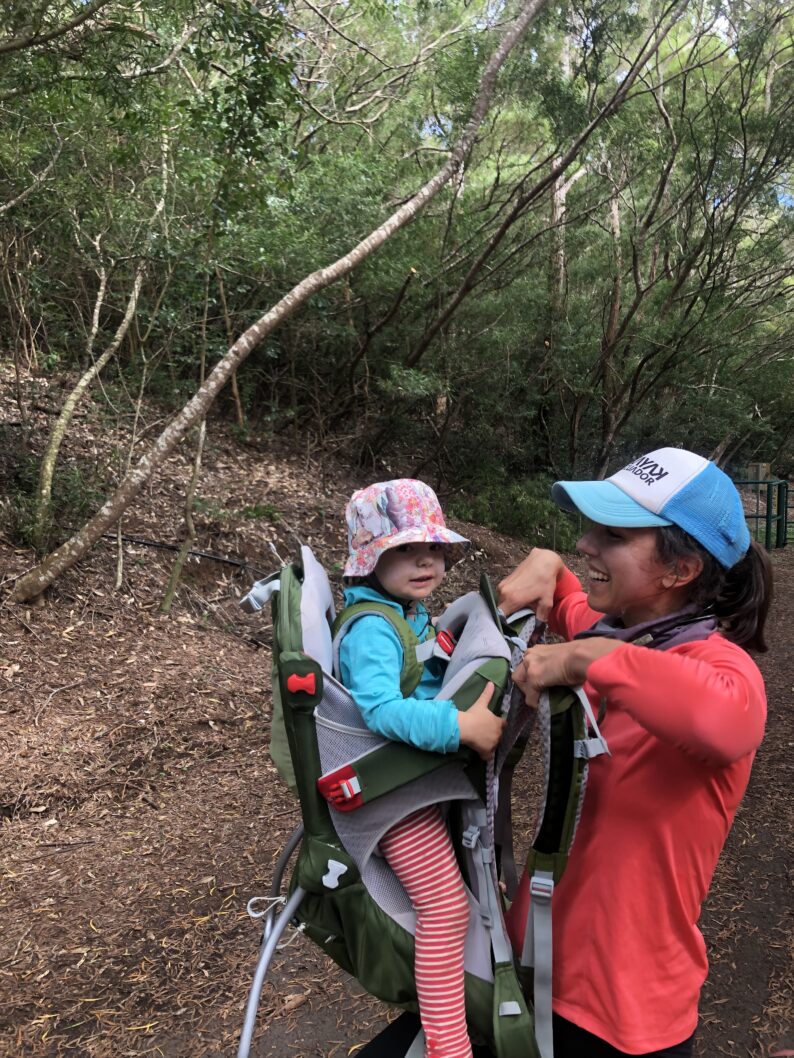
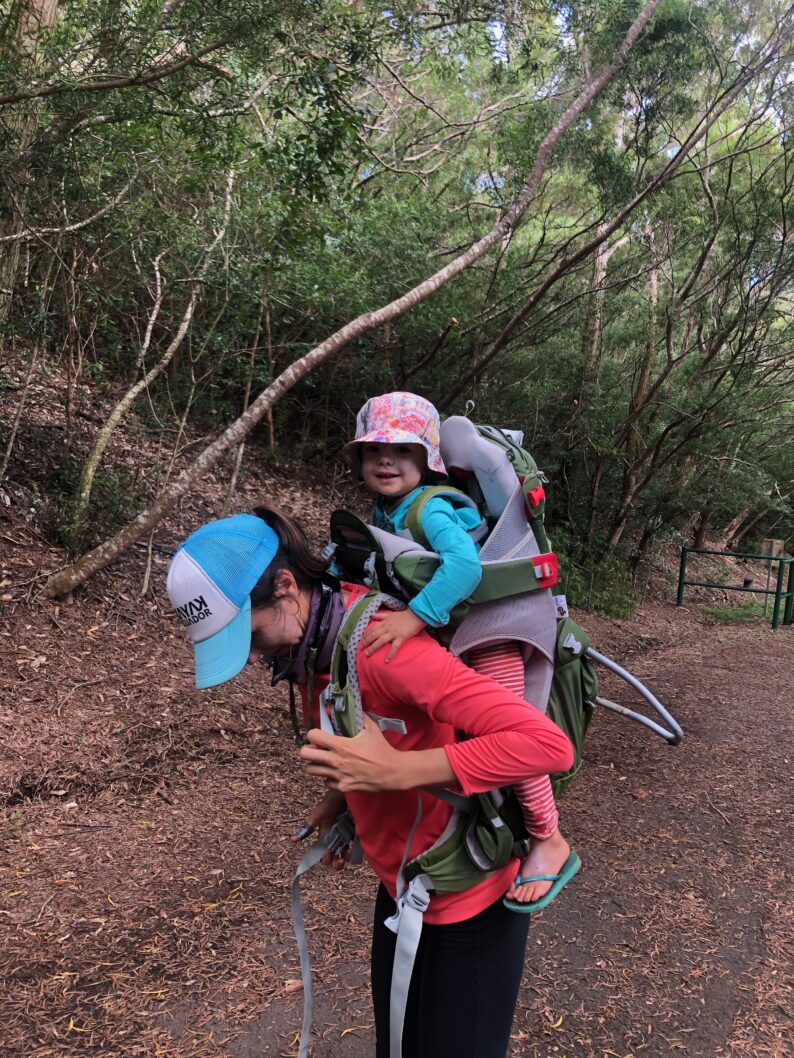
The big backpacks are more of a production getting the kid in and out. There is the harness that needs to be connected and you have to completely take the pack off to put a kid in or out of the pack while with the wrap and convertible carriers you don’t need to take the carrier off. This meant we were much more likely to let our kid get down to play and explore while on hikes with the smaller carriers.
The big advantage of the backpacks is your kid’s weight doesn’t shift to the left or right, the shade, and its ability to store gear (which makes it even more cumbersome). Overall, we are convinced the convertible carrier is a way better choice than the child carrier backpack. A few of our friends disagree but I don’t think they have tried the convertible carriers.
Baby Carriers
Concluding Thoughts on Baby Carriers
We’ve had enjoyable multi-hour hikes with all 3 of these baby carriers. While the Infantino will work fine, if you see yourself using a carrier on a daily basis the Ergo is the way to go. Baby wearing particularly with a smaller infant makes shopping and running errands so much easier than dealing with a clunky stroller that you might be using yours often. As our child has gotten older it has been nice to be able to bring along the convertible carrier in case she get tired or we just need to get going home. Our baby carrier is by far one of our most valuable pieces of gear.
Liked this article, you might enjoy our Stohlquist infant lifejacket review and a break down on the 3 most popular types of flotation devices for kids.
